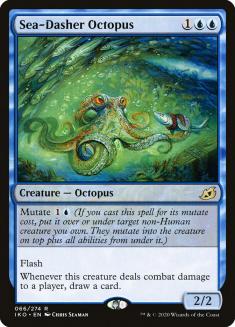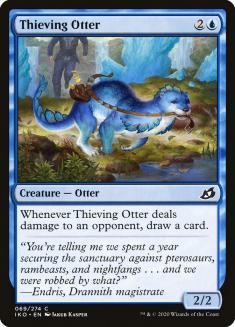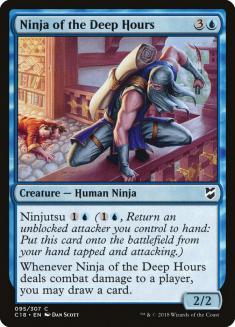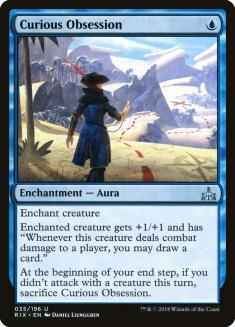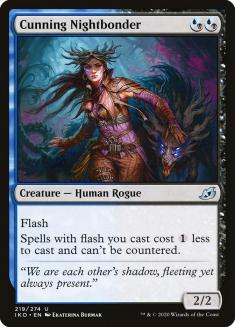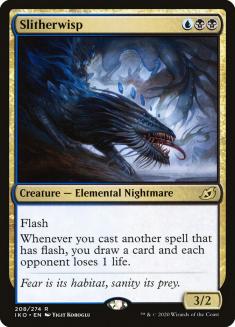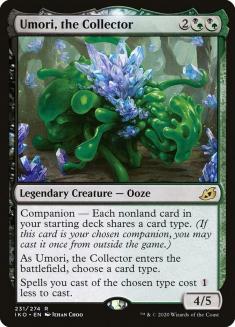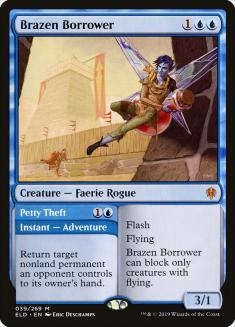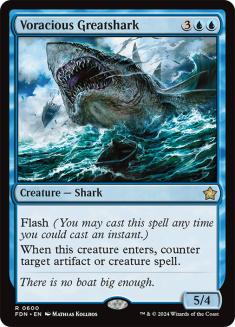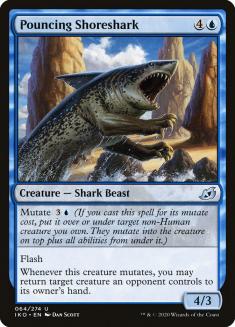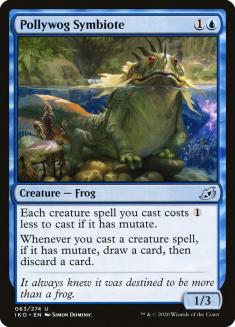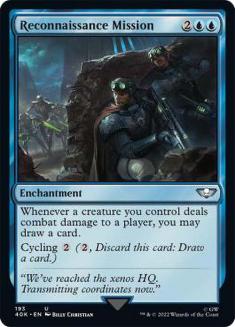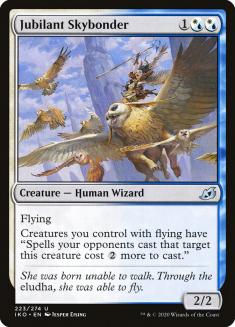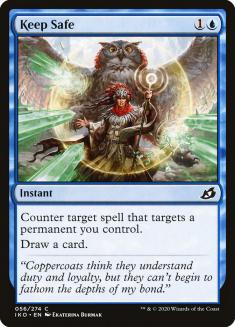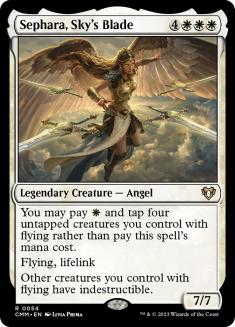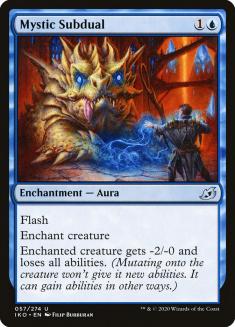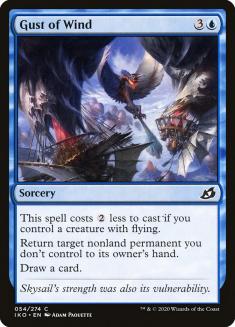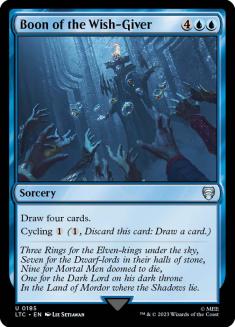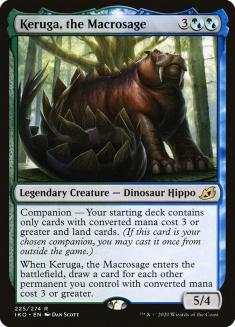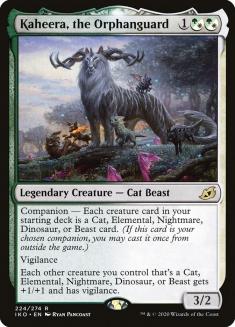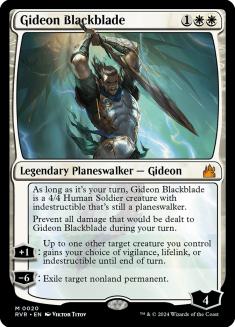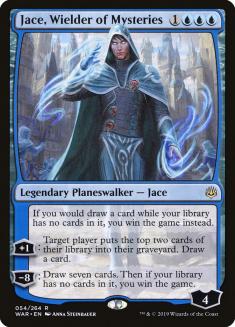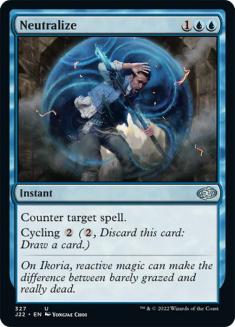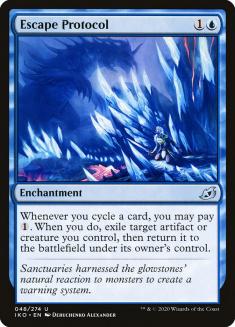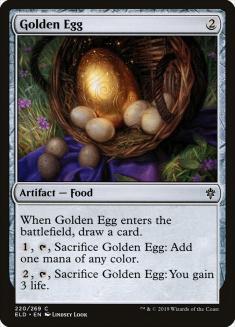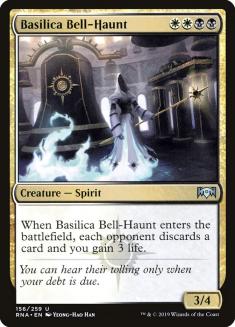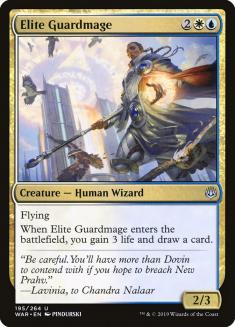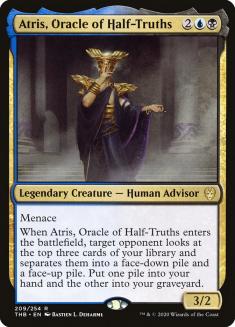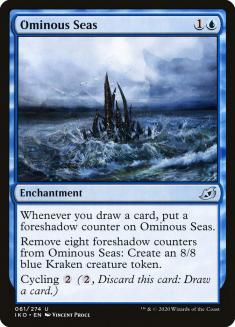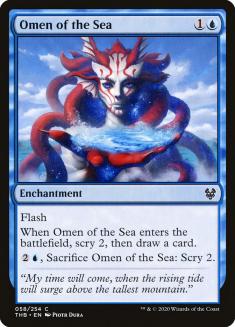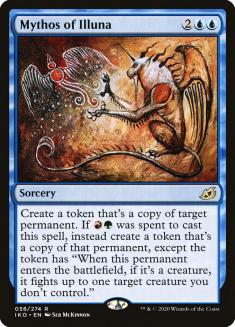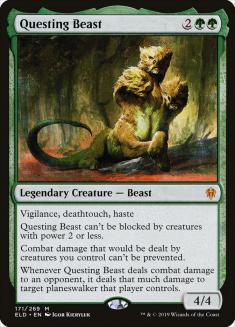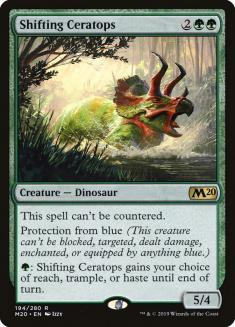Today’s focus is on the blue cards of Ikoria, Lair of Behemoths. A review of the Ikoria’s white cards can be found here. There’s a lot of ground to cover, so let’s jump in.
Sea-Dasher Octopus
Sea-Dasher Octopus is mainly a Thieving Otter with flash and mutate, making it kind of a Ninja of the Deep Hours and kind of a Curious Obsession.
Strengths: Such an inexpensive mutate, it’s a very efficient play on Turn 2. In a deck with lots of cheap evasion creatures, we’re frequently going to be able to draw a card immediately when we cast it. This makes us really want to use it with one-drops, and unlike some mutate cards, it doesn’t mean we have to go all-in or anything.
Weaknesses: It’s quite vulnerable to cheap interaction (at a potential tempo loss) and gets out-classed by most creatures, so it really tends to want to be mutating with something (which can then leave us vulnerable to getting two-for-one’d). It also works best with cheap creatures, and if we play a lot of underpowered creatures that work especially well with the Octopus, our deck might play out poorly when we don’t draw it.
Opportunity: If we use it in a tempo deck, we can really leverage the snowballing card draw. If we combine it with the powerful new flash-enablers, we can greatly reduce the risk it carries.
Cunning Nightbonder and Slitherwisp both look incredible and I expect a new Tier 1 deck to emerge playing them both. We’ll be exploring them more thoroughly later in the week, but for now, suffice it to say I expect them to be very impactful.
Creatures (35)
- 4 Spectral Sailor
- 4 Brineborn Cutthroat
- 3 Murderous Rider
- 2 Blacklance Paragon
- 4 Brazen Borrower
- 3 Pouncing Shoreshark
- 3 Voracious Greatshark
- 4 Sea-Dasher Octopus
- 4 Cunning Nightbonder
- 4 Slitherwisp
Lands (25)

I definitely have not wrapped my head all the way around companions yet. Is it just supposed to be the starting point of decks that you default to assuming you’re going to pick one to play, and choosing to not play one should involve making an intentional sacrifice?
A 4/5 for four is not the worst body, and the cost reduction ability seems excellent here. Yeah, it doesn’t have flash, but who cares? It’s just an eighth card we get for free. It does make me want to play a little more land, since we have an extra spell at the start of the game. Not playing with sorceries and instants (or enchantments with flash) is definitely a cost, but we even have excellent options for “fake” instants.
Brazen Borrower and Murderous Rider not counting against us for Umori is so big, and if these new, more expensive flash creatures pan out, we could be in real good shape.
Voracious Greatshark is quite the Frilled Mystic, and while only hitting artifacts and creatures may seem limited, consider how mean of an Angel of Grace impression it can do.
When countering creatures isn’t good, usually one of two things is true: we’re behind on the battlefield, or our opponent isn’t playing a lot of creatures. If we’re behind, Voracious Greatshark can be a great surprise blocker or tactical tool for taking down planeswalkers. If our opponent doesn’t play many creatures, such a hard-hitting flash threat can still just be a great game piece on its own (and that’s to say nothing of countering a Dream Trawler, aka The Dream).
Pouncing Shoreshark seems like it could actually turn out to be great. The ability to permanently buff our creature in combat while also getting a bounce spell out of it seems like it’s got big Faeries energy, and it really sets up our Greatshark nicely.
Threats: This specific Umori list is vulnerable to big plays, Ultimatums, any kind of a ramp deck, and so on. That’s generally going to be a risk to playing all creatures. Just looking at the Dimir Flash archetype, however, we’ve got a lot of creatures vulnerable to Shock and Lightning Strike. Any strategy sufficiently fast might be able to “duck under” the Dimir deck and actually tempo them out. Teferi, Time Raveler could be a real pain (though we do have mutate for “virtual haste,” such as Pouncing Shoreshark causing a Spectral Sailor to hit Teferi for four instead of one).
Despite these threats to the strategy, this path looks incredible to me and is one of the directions I’m most interested in pursuing. Whatever decks we build might want to keep this style in mind, as there’s a possibility of some of the Faeries experience, with some strategies just not being realistic against this style of deck.
The Octopus and Shoreshark could also be used in a dedicated mutate build, supported by Pollywog Symbiote.
Pollywog Symbiote is one of the loudest mutate build-arounds in the set. While it’s good with every mutate card, it works deceptively unevenly when you consider the cost reduction ability with relation to mutate costs that have all colored mana symbols. We’ll be looking more closely at mutate decks later in the week, but here’s a starting point for a dedicated Sultai Mutate list for now:
Creatures (36)
- 3 Migratory Greathorn
- 4 Boneyard Lurker
- 4 Pouncing Shoreshark
- 4 Zagoth Mamba
- 4 Pollywog Symbiote
- 2 Dirge Bat
- 3 Gemrazer
- 4 Mysterious Egg
- 4 Sea-Dasher Octopus
- 4 Essence Symbiote
Lands (24)
Sideboard

Reconnaissance Mission
Reconnaissance Mission is basically a Coastal Piracy with cycling, a powerful callback to Biden of Thassa. While it’s on the battlefield, every creature is a must-kill or must-block threat.
Strengths: Combine it with cheap evasion creatures and you can build an overwhelming advantage quickly. It adds such an incredible amount of value to any temporary battlefield advantages you might have that it makes tempo cards much better than they’d usually be. Cycling means you’re not stuck with it in hand when you have no creatures, and unlike Bident of Thassa, it’s not legendary.
Weaknesses: Needs cheap evasion creatures, which might not be what you want when you don’t have the Mission. It also doesn’t “do anything” on its own, so there’s some risk of instant-speed removal in response putting you behind.
Opportunity: We could start by building a Skies deck, as there’s already a lot of infrastructure for such a strategy. Sea-Dasher Octopus and Staggering Insight offer a ton of possible ways to do this sort of a thing.
Creatures (24)
- 4 Healer's Hawk
- 4 Pteramander
- 4 Spectral Sailor
- 4 Brazen Borrower
- 4 Sea-Dasher Octopus
- 4 Skycat Sovereign
Planeswalkers (4)
Lands (21)
Spells (11)
Sideboard

I looked at Jubilant Skybonder and Keep Safe, but only impacting spells and not abilities is just too much a weakness to immediately warrant exploration.
If we ended up playing a version without the two-cost card draw enhancers, there’s something to going wide with Reconnaissance Mission and Sephara, Sky’s Blade, but it seems too fragile and filled with too many low-powered cards.
The mana looks too bad in this deck anyway. With both Sea-Dasher Octopus and Reconnaissance Mission in the mix, why do we even need white anymore?
Creatures (22)
- 4 Pteramander
- 4 Spectral Sailor
- 4 Brineborn Cutthroat
- 4 Brazen Borrower
- 4 Sea-Dasher Octopus
- 2 Cunning Nightbonder
Lands (20)
Spells (18)

It’s not the flashiest, but I want to give Mystic Subdual a shot.
That it both has flash and removes abilities (including flying) makes me think it might be deceptively versatile, and besides, we might not want all bounce.
That said, Gust of Wind might just be a solid card. The big strike against it, for me anyway, is not being able to save your own creatures. When you stack that on top of only having access to eight one-drop flyers, I want to be cautious here.
Threats: This style of deck can be quite vulnerable to fast aggro, and if it’s not the kind of aggro Cerulean Drake and Aether Gust help against, we may need to rethink our plan. Uncounterable creatures might be difficult threats, and creatures with enters-the-battlefield abilities may exploit our over-reliance on bounce (especially if we’re talking Kraul Harpooner). Finally, if somebody just keeps us from getting ahead, we’re not the best at playing from behind.
Boon of the Wish-Giver
Boon of the Wish-Giver is a pretty straightforward sorcery-speed Opportunity with cycling for one (and only targeting yourself). It can be used “fairly,” where we’re hoping to build advantage in our control deck when we can afford it, or cycle it when we can’t. It can also be used “unfairly” as part of some combos we’ll be seeing later in the week, focusing on it first as a cycling 1 card that sometimes draws us four.
Strengths: Boon of the Wish-Giver is a massive source of card advantage late-game, with minimal risk early-game.
Weaknesses: Tapping out to cast Boon is definitely taking a risk, so we’ve got to be realistic about how strong the effect actually is when we do it. Also, cycling 1 is pretty wild, but it’s not free. When we’re cycling it, we may want to compare it to cards like Opt and Temple of Enlightenment.
Opportunity: If the sorcery-speed liability is mitigated, the more we play like a tap-out deck anyway. This makes me want to look at cards like Elspeth Conquers Death, since it’s a very powerful tap-out threat that can help put us ahead and ensure we’re not killed the turn we tap out for Boon. Using it with white is more attractive to me than green, as there it’d be competing with Hydroid Krasis and Uro. Black has much incentive to play at instant speed; it looks like it’d be a real cost there. Red is an interesting question and a direction I’ll be exploring later, but the short version is that red doesn’t have as powerful of tap-out threats as white.
Creatures (4)
Planeswalkers (8)
Lands (27)
Spells (21)

Narset does suppress drawing cards from cycling, but remember, they do get one freebie per turn, so they can cycle one card on each of your turns and still draw from it.
Perhaps the most notable feature of this proposed list is the use of two companions (a tactic I don’t think people are giving enough consideration).
This list starts as a Keruga deck, maybe sacrificing a couple of Dovin’s Vetos and a couple of Aether Gusts, or something like that. Keruga is more than just an extra card. It gives us a powerful tool for building card advantage, capable of drawing extra cards from Teferi, Narset, Borrower, and all the white enchantments.
From looking at the available cards, I’m not sure we’ll be able to defend ourselves quickly enough against fast aggro. Not being able to play cards that cost two or less is a serious limitation (even if cards like Brazen Borrower let us work around this). To this end, I’m experimenting with a “transformational sideboard.” When we need to bring the two-mana removal in, we switch commanders companions (remembering to replace the Borrower and Dream Trawler with the sideboard planeswalkers).
We’re not completely forbidden from playing creatures, of course. They just need to be Beasts, Cats, Dinosaurs, Elementals, or Nightmares. For instance, I’m going to start by experimenting with sideboarding Keruga in for those matchups. It’s not necessarily the best threat in the world, but it might be okay and we could use more win conditions. We even draw a card from our Kaheera!
I’m not sure it’s high-impact enough, but if we’re just bringing it in for aggro matchups anyway, maybe Maned Serval is a good blocker for us. It even gets +1/+1 when we cast our “free” 3/2 out of the sideboard.
I started with three Boon of the Wish-Giver, but Keruga is such a powerful source of card advantage, I moved to a Shark Typhoon in place of one, giving us another victory condition (even post-sideboard) and an added angle of attack, especially for fighting opposing planeswalkers, where we might value the instant-speed threat or just need to go over the top of somebody with lots of sharks.
Worse than Sinister Sabotage in general, to say nothing of Absorb, so you gotta be extra into the cycling for Neutralize to make sense.
Threats: Whether this transformational plan even works is an outstanding question, but generally, fast aggro is a potential serious threat, and the more we bend our list to fight them, the more vulnerable we’re likely to become to decks going big, particularly Hydroid Krasis decks.
Another approach I’m interested in with Shark Typhoon is alongside Escape Protocol in a dedicated cycling deck.
Escape Protocol
Escape Protocol is a potentially abusable Astral Slide variant that really makes us interested in enters the battlefield abilities. Once we’re loading up on enters the battlefield abilities, the natural place to turn is Yorion, Sky Nomad.
Of course playing 80 cards is a serious cost, but the more cheap cycling we play, the more we mitigate this cost. Besides, this is an absolutely incredible power to have access to every game, right? Like, this could easily be a four-for-one or five-for-one in a lot of games.
While I assumed blinking creatures would be the better path, I wanted to consider blinking artifacts.
There’s some natural overlap with Doom Foretold, so I tried building something along those lines, but the result kind of makes me feel like Escape Protocol is wrong for the deck.
Creatures (2)
Planeswalkers (6)
Lands (31)
Spells (41)
- 3 Kaya's Wrath
- 2 Oath of Kaya
- 4 Guild Globe
- 4 Golden Egg
- 4 Doom Foretold
- 3 Treacherous Blessing
- 3 Elspeth Conquers Death
- 2 Shatter the Sky
- 4 Boon of the Wish-Giver
- 1 Shark Typhoon
- 3 Escape Protocol
- 4 Frostveil Ambush
- 4 Startling Development
Sideboard

Yorion is incredible with Doom Foretold cards, retriggering everything. It even resets Narset and Elspeth Conquers Death. Sadly, Escape Protocol only hits artifacts and creatures, though, so I think this version is trying to do too much.
In looking at creatures to blink repeatedly, one of the most abusive possibilities is Basilica Bell-Haunt. You can keep blinking it to wear down your opponent’s hand, and then when they’re empty, just keep blinking it on their draw step each turn.
Creatures (26)
- 4 Basilica Bell-Haunt
- 1 Angel of Grace
- 1 Fblthp, the Lost
- 4 Elite Guardmage
- 1 Cavalier of Dawn
- 2 Agent of Treachery
- 3 Atris, Oracle of Half-Truths
- 4 Flourishing Fox
- 4 Drannith Healer
- 2 Yorion, Sky Nomad
Planeswalkers (4)
Lands (31)
Spells (19)
Sideboard

There are so many creatures really worth blinking, I wanted to focus on card quality rather than trying to build up the lock.
As far as additional lock pieces go, I’m more interested in trying Agent of Treachery before any Ravenous Rats or Yarok’s Fenlurkers.
Really? You’re just gonna name the fiddly two-cost blue enchantment Ominous Seas the set after Omen of the Sea?
Ominous Seas is another possible direction for these cycling decks, particularly if you go all-in. Here’s a starting point for one such strategy:
Creatures (8)
Planeswalkers (4)
Lands (23)
Spells (27)

The ceiling is pretty high on a one-mana draw-two, but this one might need to target a slightly bigger format than Standard. My first attempt at making a Standard list needed to stretch to three colors and leaves me less confident in the mana than I’d like to be.
Creatures (29)
- 4 Lovestruck Beast
- 1 Rosethorn Acolyte
- 4 Faerie Guidemother
- 4 Giant Killer
- 4 Edgewall Innkeeper
- 4 Shepherd of the Flock
- 4 Fae of Wishes
- 4 Brazen Borrower
Lands (23)
Spells (8)

If we move up in formats, suddenly the world is our oyster (as we’ll see later in the week), with Humans like Snapcaster Mage and Jace, Vryn’s Prodigy playing especially well with it.
Mythos of Illuna
Mythos of Illuna is a Clone variant that can hit permanents (not just creatures), and can even copy something of your opponent’s. What’s more, when played in Temur, it can frequently give us an extra removal spell on top of everything else (which Temur is usually short of).
Strengths: This is just a much more versatile Clone variant than most, and the potential for extra card advantage and positional advantage demands exploration on account of its excellent rate.
Weaknesses: Unlike many Clones, this one targets when you cast it and if the target is no longer valid, the spell will fizzle. What’s more, it doesn’t count as a creature in your deck, putting some tension on our ability to play Gyruda or Umori.
Opportunity: If we play a reasonable number of creatures that fight well, we’re more likely to get that kill spell kicker on top of the Clone. This has me looking at creatures like Questing Beast and Kogla, the Titan Ape.
Here’s an attempt to build around Mythos, while also satisfying Gyruda:
Creatures (21)
- 4 Sphinx of Foresight
- 4 Incubation Druid
- 4 Paradise Druid
- 4 Questing Beast
- 4 Kogla, the Titan Ape
- 1 Kinnan, Bonder Prodigy
Lands (24)
Spells (15)

Castle Garenbrig is tight with Kogla, just saying….
Technically, we can still play Incubation // Incongruity, despite both halves costing odd amounts, since Gyruda considers the card to cost four. And of course, technically correct is the best kind of correct.
An important note here, Shifting Ceratops can’t be copied with Mythos of Illuna, so be careful there.
Finally, here’s an attempt abandoning the need for companionship altogether:
Creatures (23)
- 4 Hydroid Krasis
- 4 Paradise Druid
- 4 Gilded Goose
- 4 Questing Beast
- 4 Uro, Titan of Nature's Wrath
- 3 Kogla, the Titan Ape
Planeswalkers (3)
Lands (24)
Spells (10)
Sideboard

Threats: The biggest threats to Mythos of Illuna are people who refuse to engage with you in the battle of who has the best creatures. Additionally, this strategy, more than most, is potentially vulnerable to getting tempo’ed out by decks like the Dimir and blue decks above. This is something we’ve got chances to improve with card quality, but we’ve really got to make it a priority.
That’s a wrap for today, but we’ll be back here tomorrow to dive head-first into the black cards of Ikoria.



